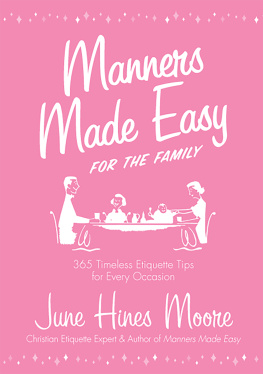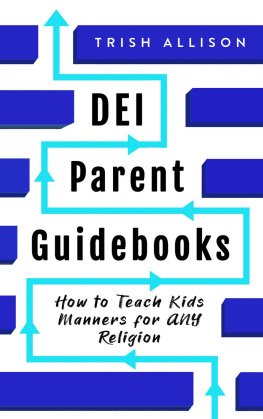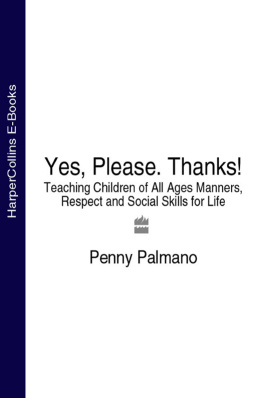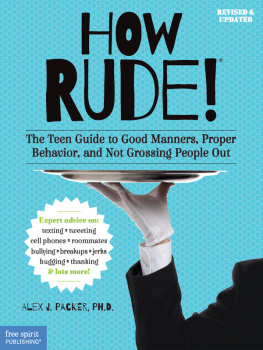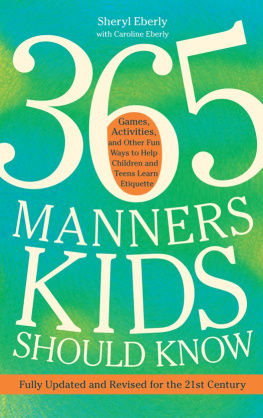
The author and publisher have provided this e-book to you for your personal use only. You may not make this e-book publicly available in any way. Copyright infringement is against the law. If you believe the copy of this e-book you are reading infringes on the authors copyright, please notify the publisher at: us.macmillanusa.com/piracy.
Contents
To William and Timothy, who want everyone to know that they arent perfect either,
and to my mother-in-law Peggy, who did such a good job with Rick
Acknowledgments
My mother started it all, of course, and I have to thank her for the confidence to manage almost any social situation, as well as a thorough grounding in thank-you notes.
I would never have dreamed of writing about manners if I hadnt spent hours and hours studying manuals by Letitia Baldridge, Marguerite Kelly, Judith Martin and Marjabelle Young Stewart. To that foundation I have added a great deal of advice from friends and relatives, including Barbara Butler, Lisa Callahan, Nancy Casserley, Clarice Cole, Pat Emery, Wendy Hilboldt, Laura Lloyd, Nanci McAlpin, Gioia Pastre, and Eve Wallace.
And this information would never have made it into book form without the ever-stalwart help of my agent Lynn Seligman, and the faith and vision of my editor Hope Dellon and her colleague Jenny Notz.
Introduction
Most parents would like their children to have good manners. Who wouldnt want to hear Please and Thank you at dinnertime, and have the door held open by a small person in sneakers? Certainly we all hope that as adults our children will be comfortable and self-possessed in a range of circumstances. The French term savoir-faire perfectly expresses the notion of knowing how to do things in different situations.
But the very idea of teaching manners causes a lot of anxiety, and for good reasons. We all feel overburdened: Surely manners can wait until we get Johnny potty trained/reading/into college. Everyday discipline is hard enough to manage. Who would be fool enough to add all this extra behavior that has to be monitored? We need to teach our children the skills that will help them cope in the world, and manners often dont seem that important.
I believe, though, that good manners are an essential part of our childrens education. Behaving courteously to the people around you is a skill, too. And its important for a basic, if cynical, reason: People with good manners are more likely to get what they want. Imagine this scenario: There are two children in your kitchen. One says, Mrs. Parker, could I have a glass of juice, please? (This is well within the capability of the average five-year-old). The other says, I want some juice, and tries to grab the cup from your hand. Which kid is going to get her juice first?
This example also points out something important about manners: They have to be taught. Its all very well to believe that a childs innate good nature will make her behave lovably. But this simply isnt true. A large proportion of mannersparticularly those concerning eatinginvolves going against your instincts. Waiting to be served, waiting to eat, tasting things you dont like the looks of, taking small bites and chewing with your mouth closedthis is the behavior that civilized Western society expects. These manners dont come naturally. They must be learned and practiced until, with time, they become habit.
If a portion of the behavior that we consider polite is arbitrary, its still true that a good deal of it does spring from simple consideration for other people, like opening a door for someone whos carrying shopping bags, or offering to bring a drink from the kitchen for anyone else who wants one. For most of us, considerate behavior has to be learned, too. Left to themselves, many children (and many adults) are not in the habit of thinking about what would be helpful, kind, or convenient for the people around them.
Whats more, the Baby Boom generation has an extra handicap when it comes to manners. Having come of age in an era that made a point of discarding old-fashioned behavior, we have some trouble deciding what constitutes politeness. Is it all right for children to call grown-ups by their first names? And do you really have to write thank-you notes? And why cant you put your elbows on the table during meals, anyway? (Sometimes the answer is simply, Because thats the way its done.)
That is why I wrote this book. Manners move with the times, and the etiquette books I grew up with often suggest behavior that I dont think is appropriate any longer. My children are pretty polite, but I have not taught them to stand up when an adult enters the room. We live in an informal neighborhood so there are many adults whom they call by their first names. Im not crazy about it, but Ill certainly go along with accepted practice. I am not interested in raising children whose behavior seems quaint: I just want them to be pleasant to have around.
With that goal in mind, I havent emphasized especially formal behavior in this book. Im more concerned with getting children to use any fork at all than with coaching them on the proper use of the fish fork. There are a couple of boxes on specific foods that require specific treatment, but since artichokes dont appear on our menu all that often, I havent concentrated on that kind of thing.
Standards vary for different ages, too. You probably cant count on a six-year-old to introduce friends to each other, or a four-year-old to answer the phone politely. But any child who talks can say Please and Thank you. This book is broken down by age groups to help you decide whats appropriate behavior at which age. And, yes, there are general expectations about manners. A seven-year-old cant get away with the kind of shy nonresponsiveness thats forgiven in a preschooler, for instance.
The idea here is that by the time your child turns six, he should be familiar with the concepts outlined in Part I, Basic Training. Notice that I do not say he should have mastered them. At no time are you going to feel that your job is done: Teaching manners is one of parenthoods many unending tasks. Familiarity means that when you say, Honey, can you remember to hold the door open for Aunt Martha? this will not be a startling and radical notion. Holding the door should be a much-discussed feat that has been successfully carried out on several occasions, but not necessarily without prompting.
The sections of this book are cumulative. In other words, the polite world (your parents and mine) will expect a child of six to nine to be acquiring the behaviors in Part II, The Age of Reason. And to have acquired those in Part I. By the preteen years, ten to twelve, a child should be learning the manners suggested in Part III, The Young Sophisticate, as well as exhibiting with some consistency the manners set out in the earlier sections of the book. Some kinds of courtesy, like table manners and phone manners, appear in each section of the book, because what we expect of children in these areas changes as they get older. Other sections are specific to certain ages: Theres no need to worry about romantic behavior with a seven-year-old, for instance. (For easy reference, Ive listed the rules at the beginning of each section.) I dont go into manners for teenagers because Im afraid if you havent caught your kids before then, its a little late to start. Part IV outlines some specific ways we can make it easier for our children to learn good manners.
You will not be able to make your child perfect. Ever since I began working on this book, my friends have bombarded me with impossible dilemmas. What can I do about Simon, who interrupts all the time? Josie said in the loudest voice, Why dont you have any hair? and I thought I would die. Mark just wont talk to our adult friends when they come over. Having good manners doesnt mean you never embarrass anyone or hurt anyones feelings. What I hope for from my children is that overall, their behavior expresses respect and consideration for the people around them, and familiarity with the conventions of Western table manners. William is never going to overflow with exuberant small talk, and I will probably be nagging Timothy about talking with his mouth full until he leaves home for college. But already, at eight and five, they shake hands when they meet people, hold doors for grown-ups, and clear their places after meals.
Next page







